| |
|
|
50.
| Crossing the line |
| |

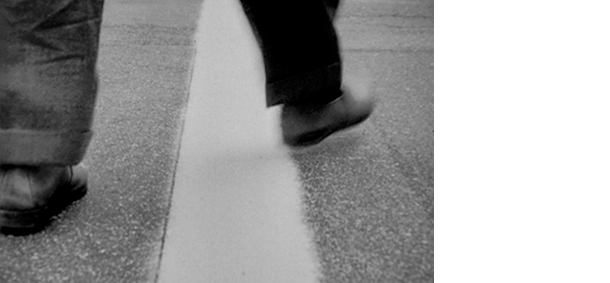
2014-2015, diptych, pigment print on fine art, 68.5 x 105 cm.
Exhibition view of Inside the Fire Circle, Lawrie Shabibi Gallery, 2017, Dubai.
Courtesy of the artist and Lawrie Shabibi, Dubai.
Ed. of 5 + 2 A.P.
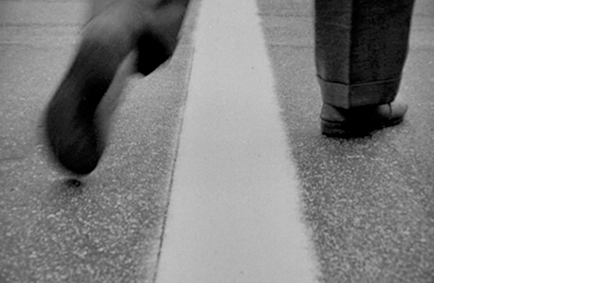
2014-2015, diptych, pigment print on fine art, 68.5 x 105 cm.
Exhibition view of Inside the Fire Circle, Lawrie Shabibi Gallery, 2017, Dubai.
Courtesy of the artist and Lawrie Shabibi, Dubai.
Ed. of 5 + 2 A.P.
'' In Crossing the Line, the images depict the lower part of a man’s legs as he steps over a white line on a street.
This brief moment of an everyday movement considers the notion of crossing over into something else: from white to black, light to dark, privilege to outcast. ''
Lawrie Shabibi, March 2017
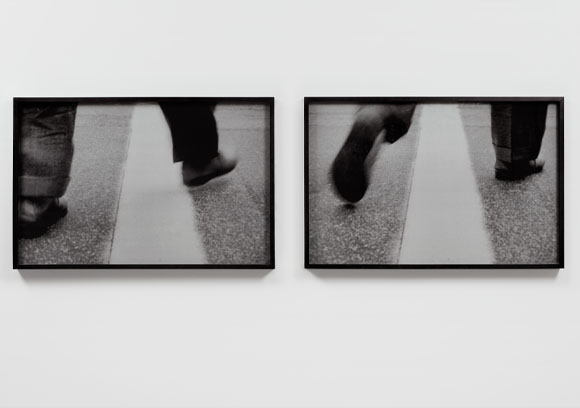
Crossing the line
Exhibition view of Borders, James Cohan Gallery, 2019, New York.
Courtesy of the artist.
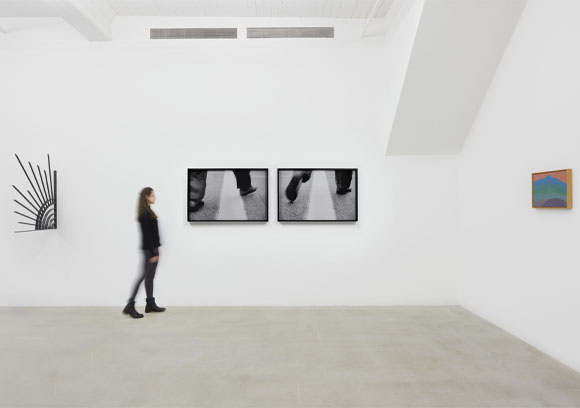
Crossing the line
Exhibition view of Borders, James Cohan Gallery, 2019, New York.
Courtesy of the artist.
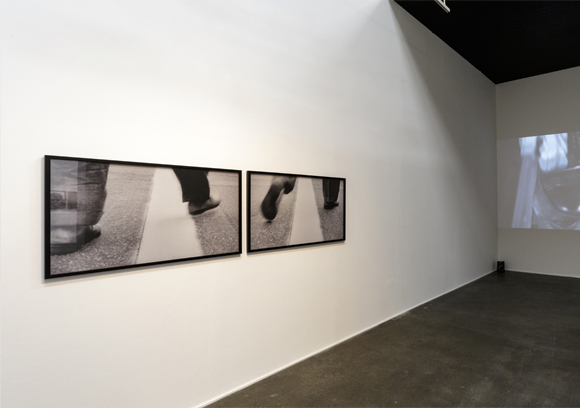
Crossing the line
Exhibition view of Inside the Fire Circle, Lawrie Shabibi Gallery, 2017, Dubai.
Courtesy of the artist and Lawrie Shabibi, Dubai.
|
|
|
|
|
|
Crossing the Line est un diptyque composé de captures d’écran légèrement retravaillées, tirées de la bande annonce de As a Black Man, un film sur la vie de John Howard Griffin. Mounir Fatmi a eu l’autorisation d’accéder aux archives de John Howard Griffin et depuis 2104, il utilise certaines des images qu’il y trouve et s’en inspire pour développer une œuvre autour de la vie hors normes de Griffin sous forme de photos, vidéos ou d’installations.
Les deux images de Crossing the Line montrent le bas des jambes d’un homme en mouvement au moment où il franchit une ligne blanche dans la rue. Les images sont granuleuses et légèrement floues. Le pantalon à revers suggère un style des années 1950 ou 1960, époque à laquelle le film a été réalisé, et les chaussures usées indiquent qu’il s’agit d’un homme aux revenus modestes. À part cela, c’est une image anonyme qui aurait pu être prise dans n’importe quelle ville américaine. Mais la signification de ces photographies est plus profonde, elles sont emblématiques de la vie de Griffin, un homme qui a choisi de littéralement se transformer en un autre pour essayer de comprendre réellement et personnellement son expérience et sa réalité.
Ce moment tout simple où il franchit une ligne blanche représente dans ce contexte le moment où il franchit la frontière vers quelque chose d’autre : de blanc à noir, de la lumière à l’obscurité, des privilèges aux franges de la société, et les conséquences qui découlent de ce changement. Il y a une véritable force dans ce pas. Dès l’instant où Griffin a été perçu comme un noir, sa vie a changé du tout au tout. Ce qui était normal est devenu irréel, si ce n’est cauchemardesque. Pour Griffin, un homme qui a fait des études supérieures et servi dans l’armée américaine, trouver un emploi est devenu quasiment impossible. Il n’a que pu trouver un travail de cireur de chaussures, un emploi peu rémunéré et précaire, expérience qui a inspiré Fatmi pour réaliser le film Darkening Process. Suite à sa transformation, Griffin a commencé à vivre dans la pauvreté, sans aide de quiconque, et a fini par mourir ainsi. Pour Griffin, le simple fait de traverser un quartier hostile aux noirs était devenu risqué. Des lieux où il se promenait auparavant sans réfléchir étaient devenus dangereux pour lui. Là où il était accepté, dans des restaurants ou magasins, même entouré d’amis, il était désormais vu comme un étranger. Socialement, l’acte de Griffin fut perçu comme le franchissement d’une ligne qu’on ne peut retraverser. Certains estimèrent qu’il était allé trop loin, c’était trop extrême pour être compris, et en conséquence, à l’exception de quelques personnes, il fut ostracisé par tous : blancs, noirs, journalistes, historiens, amis et étrangers.
En 2016, l’idée de passer de l’autre côté, dans le contexte des identités de genre, est peut-être devenu une expression courante, de plus en plus acceptée, mieux comprise. Mais changer sa couleur de peau, changer de race, cela semble aussi radical aujourd’hui que cela paraissait en 1960. Par dessus tout, Griffin a endossé un statut d’outsider. Il n’était plus blanc ni noir, mais vivait dans un entre-deux, et c’est peut-être cela ce qu’il nous a laissé de plus précieux : le sacrifice de sa personne, le risque de l’inconnu, d’exister entre deux mondes dans l’espoir d’atteindre l’autre.
Blaire Dessent, janvier 2017.
|
|
Crossing the Line is a diptych composed of slightly manipulated photographed film stills from the trailer for As a Black Man, a film made about the life of John Howard Griffin. Mounir Fatmi was granted access to the archive of John Howard Griffin and since 2014 he has been using some of the images discovered within it as a point of inspiration to develop a body of work around Griffin’s unusual life, that includes photographs, video, and installation.
Both images in Crossing the Line depict the lower part of a man’s legs in movement as he steps over a white line on a street. The images are grainy and slightly blurry. The cuffed pants suggest a style from the 1950s or 1960s, when the film was in fact made, and the scuffed shoes indicate a man of average means. Otherwise, it’s an anonymous image that could be taken in any American town. But the significance of these photographs runs deeper, and they are emblematic of Griffin’s life, a man who chose to literally transform himself into the other in order to personally try to understand their experience, their reality.
This simple moment of stepping across a line in this context represents the moment of crossing over into something else: from white to black, from light to dark, or from privilege to outcast, and the consequences that resulted from this change. There is a real power to this step. The moment Griffin was seen as a black man, his life drastically changed. What was once normal turned to the surreal, if not nightmarish. For Griffin, a college educated man who served in the US Army, finding a job became near impossible. He was only able to find work shining shoes, a job which didn’t offer much financial gain or security, an experience about which fatmi was inspired to make the film, Darkening Process. Following his crossing over, Griffin began living in poverty, with no assistance, and was to eventually die this way. For Griffin, the very act of crossing into a neighborhood hostile to blacks became a risk, a threat. Where he once walked without giving any thought to where he was, became dangerous. Where he was once accepted, in restaurants or stores, and even among friends, he was now a seen as an outsider. Socially, Griffin’s act was seen by many as crossing a line that you cannot return from. In their view he went too far, it was too far out to comprehend, and therefore, except for a few people, he was ostracized by all: whites, blacks, journalists, historians, friends and strangers.
In 2016 the idea of crossing over, in the context of shifting genders, is perhaps an increasingly common term, one that is becoming accepted, more sympathetically understood. But shifting into another skin color, another race, seems as radical today as it was seen in 1960. More than anything Griffin subjected himself to status of outsider. He was neither white nor black, rather he was living in this in-between zone, neither here nor there, and perhaps this is his greatest legacy; his sacrificing of self, the risk of the unknown, to exist in-between in an attempt to reach the other.
Blaire Dessent, January 2017.
|
|
|
|